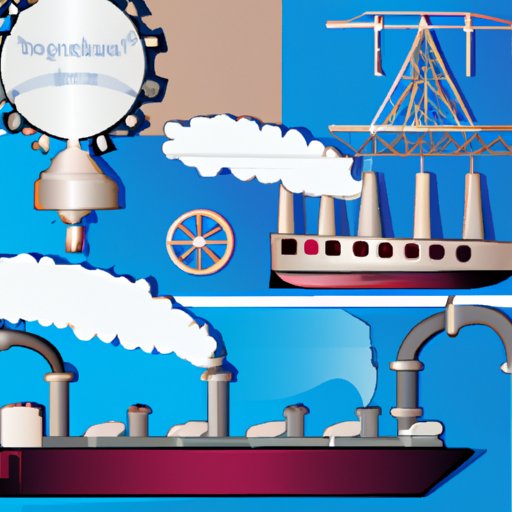Introduction
The Industrial Revolution began in England during the late eighteenth century and marked a major turning point in history. It was characterized by a shift from manual labor to the use of machines driven by steam power. Steam technology played an integral role in transforming manufacturing and industry, enabling increased efficiency, productivity, and global trade.

Examining the Development and Adoption of Steam Technology
Steam power had been used for centuries prior to the Industrial Revolution, but its application as a source of industrial energy was largely unexplored before the 1700s. The first known practical use of steam power was Thomas Savery’s invention of the steam pump in 1698. This device was used to pump water out of mines, which allowed for deeper excavation and made coal more accessible.
In 1712, Thomas Newcomen developed an engine that used steam to create a vacuum that could be used to power machinery. This invention spurred further experimentation and development of steam technology. In 1769, James Watt patented the first efficient steam engine, which was widely adopted by manufacturers. This engine was capable of powering a variety of machines and revolutionized the production process.
Watt’s steam engine was quickly adopted by manufacturers, who used it to power their factories. It replaced the traditional sources of energy such as wind, water, and animal power, which were less efficient and less reliable. By the mid-1800s, steam engines had become a staple of manufacturing and industry.

Analyzing the Role of Steam Technology in Transforming Manufacturing and Industry
Steam technology enabled a number of changes in manufacturing and industry. One of the most notable effects was increased efficiency and productivity. Steam engines allowed for machines to run faster and more reliably than ever before, which allowed for higher output. They also enabled machines to be powered by a central source instead of individual workers, which made the production process much more efficient.
Steam technology also enabled the creation of new industries. It allowed for the production of new goods, such as textiles and iron, which had previously been too difficult or expensive to produce. This led to increased competition and a decrease in prices, making these products more accessible to the general public.
Finally, steam technology also improved transportation and communication. Steam-powered trains and ships allowed for goods to be transported more quickly and efficiently than ever before. This enabled companies to expand their operations and reach new markets, while also improving communication between distant locations.
Exploring the Social, Economic, and Political Effects of Steam Technology
The introduction of steam technology had a profound effect on society, economy, and politics. On a social level, it resulted in a shift from manual labor to machine-driven work. This led to a decrease in labor costs and an increase in worker productivity, which caused wages to rise and working conditions to improve.
Economically, steam power enabled rapid industrial expansion and economic growth. Companies were able to produce more goods at lower costs, which allowed them to expand their operations and enter new markets. This led to increased competition and greater consumer choice, resulting in increased wealth for many individuals.
Politically, steam technology enabled governments to consolidate power. It allowed for faster transportation and communication, which enabled governments to extend their control over larger areas. It also enabled the construction of large infrastructure projects, such as canals and railroads, which allowed for easier transportation of goods and people.
How Steam Technology Enabled the Expansion of Trade and Commerce
Steam technology not only enabled the expansion of domestic trade and commerce, but also facilitated the growth of international trade. Improved shipping and logistics allowed for goods to be transported more quickly and efficiently than ever before. This enabled companies to expand their operations and reach new markets around the world.
Steam-powered ships also allowed for the expansion of globalization. Countries around the world were able to engage in trade with each other, exchanging goods and ideas. This led to the spread of new technologies and practices, which enabled countries to benefit from each other’s advances.
Finally, steam technology enabled the transformation of business practices. Companies were able to produce and transport goods more quickly and cheaply than ever before, which allowed them to reduce costs and increase profits. This enabled them to expand their operations and enter new markets, leading to increased competition and consumer choice.
Conclusion
Steam technology played a crucial role in the Industrial Revolution. It enabled increased efficiency and productivity, created new industries, and enabled global trade and commerce. It also had a profound effect on society, economy, and politics, leading to increased wages, economic growth, and political consolidation.
Steam technology allowed for the production of goods to be faster, cheaper, and more efficient than ever before. This enabled companies to expand their operations and reach new markets, leading to increased competition and consumer choice. Ultimately, steam technology enabled the Industrial Revolution, transforming manufacturing and industry and laying the foundation for modern society.
(Note: Is this article not meeting your expectations? Do you have knowledge or insights to share? Unlock new opportunities and expand your reach by joining our authors team. Click Registration to join us and share your expertise with our readers.)
